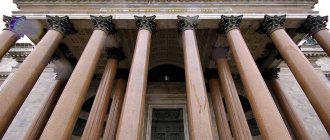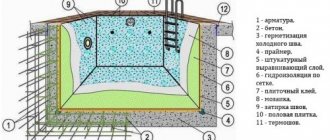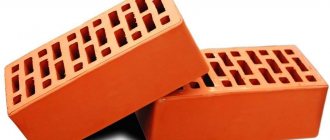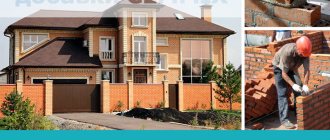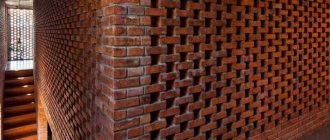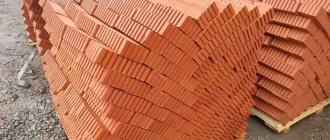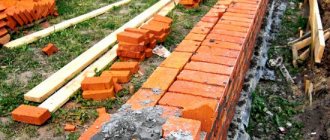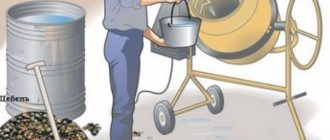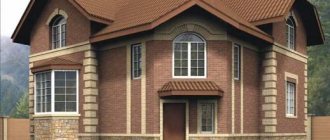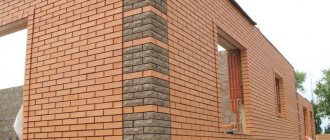Depending on the conditions of use, it is necessary to choose red bricks that have certain characteristics. This is most eloquently evidenced by its brand, which determines the compressive strength, as well as the frost resistance indicator.
Types of stone
The composition of the building material contains different components, as presented in the table:
| View | Compound | pros |
| Ceramic | Clay | Durability |
| Impurities | Versatility | |
| Silicate | 90% lime | Affordable price |
| 10% sand | High sound insulation | |
| Hyper-pressed | Calcareous rocks | Decorativeness |
| 5% concrete |
Main characteristics of building bricks
- Strength is the main parameter, responsible for the ability of a material to withstand long-term loads without further destruction. It is marked with the M brand, the digital parameters indicate the maximum load per 1 sq.cm. The brand of brick for a house can be M-100, 125, 150, 175. For large multi-storey buildings, M-150 is purchased.
- Frost resistance. A parameter indicating the number of cycles of changes in the temperature regime of masonry operation. To build houses in mid-latitudes, you need to buy a grade of solid ceramic brick of at least F-35 or higher.
Concrete plant Pride is a reliable partner that provides comprehensive turnkey supply of building materials. You can find a complete list of products on the page:
Explanation of markings
The strength and density of red and sand-lime bricks is determined according to GOST. Quality control and strength determination are carried out using a special method using the example of 1 selected stone from a batch. Designated as brick marking. Red brick brands are written using an alphanumeric system:
| Designation | Peculiarities |
| M75 | Weak strength |
| Low price | |
| M 100 | Strength allows construction of up to 3 floors and simple construction |
| Low cost | |
| M125 | Ordinary clay brick |
| High strength of bricks, construction of buildings up to 3 floors is allowed | |
| Construction of partition columns |
The M150 marking is more durable and is represented by the following types of building stone:
- Ordinary 1nf 150. Used in creating foundations, plinths, walls for high-rise buildings.
- Double. It is used for laying load-bearing walls, as it is distinguished by high strength.
M200 and M250 brands of ceramic bricks are similar in characteristics, the difference is small in the ability to withstand loads. The first bears 200 kg, and the second 250. They also have high water resistance. The following types are used in construction:
- Brick Used for load-bearing walls of multi-story buildings, strength foundations.
- Facing. Used for decorative paths.
M300 grade of brick strength is considered the most expensive. It is characterized by durability and strength, it is also called non-destructive. Often used only in the form of solid bricks, less often hollow ones. Sometimes builders use it instead of fireproof for laying stoves, baths, and fireplaces. Also suitable for external walls and basement construction.
Standardization
The grade of strength and frost resistance of bricks is regulated by GOST. This means that a batch of bricks is subject to mandatory inspection, after which it is assigned a brand. Most often, five bricks are selected at random from a batch. To determine their strength, they are given ultimate loads, and also tested for compression and bending. To test frost resistance, the brick is placed in water for 8:00, frozen through and turned into ice, and then defrosted back. This happens several dozen times in a row. How many cycles will a brick withstand before cracking, that is the grade of frost resistance it has.
Additional marking characteristics
Red brick must also meet the requirements of GOST and differ from ordinary concrete. The first characteristic, frost resistance, in the marking is indicated by the Latin letter F. The table allows you to see more detailed characteristics:
| Marking | Decoding |
| F25 | Low rate |
| Suitable for interior use only | |
| F35 | Means average |
| Used for the construction of buildings that are not constantly exposed to cold | |
| F50 | This means the level is above average |
| Demanded for facing work | |
| F75 | Indicates high criterion |
| Often used for the construction of high-rise buildings | |
| F100 - F300 | Can be used for the construction of any buildings exposed to low temperatures |
| The differences between them are small |
An important part of the labeling is the average density class of the product, as shown in the table:
| Product groups by thermal characteristics | Index |
| High efficiency | 0,7—0,8 |
| Increased thermal efficiency | 1,0 |
| Effective | 1,2 |
| Conditionally effective | 1,4 |
| Ordinary thermal effect | 2,0 |
| Minimum efficiency | 2,4 |
Brick strength
The selection of a specific type of building material is based on the required characteristics, where the main thing is the level of strength. The latter is indicated in the name of the brand, which is of type M100, M125, M150 or others. To determine a specific parameter, tests are carried out to determine the compressive strength, and for thickened, ordinary and clinker, also bending. The real indicator is assessed on 5-15 individual samples from the batch (the specific number depends on the type of material and types of testing) subject to the following requirements:
- the brick is in an air-dry state, that is, it is pre-dried in a cabinet to remove residual water and stabilize its weight;
- the supporting surfaces are ground so that the deviation from flatness along the supporting surface does not exceed 0.1 mm for every 100 mm of length, and the deviation from parallelism does not exceed 2 mm;
- to study the tensile strength under bending loads, one brick is used, and for compression, two, which are laid in beds one on the other
The compression test itself is carried out by placing the samples on the base plate of a special machine with their geometric axes aligned. The load level should increase in such a way that failure of the sample occurs no earlier than after one minute.
Determination of strength to bending loads is carried out by placing the sample on 2 supports, and the load is applied in its central part with a uniform distribution over the entire width. The load change must occur at a constant rate so that failure occurs within 20-60 seconds after the start of the test.
Specific strength parameters for each brand are:
- M100 – compression 10 MPa, bending – 2 MPa (for solid), 1 MPa (for hollow);
- M125 – compression 11 MPa, bending – 2.4 MPa (for solid), 1.2 MPa (for hollow);
- M150 – compression 12 MPa, bending – 2.7 MPa (for solid), 1.5 MPa (for hollow).
Varieties and applications
Depending on their purposes and characteristics, the following types are distinguished, which are presented here:
| Type of stone | Brick characteristics | Application |
| Full-bodied | Low void volume, less than 13% | Foundation |
| Conducts heat well | Construction of columns | |
| Product weight 3.5 kg | Ground floor | |
| Hollow (pu) | Accommodates voids up to 50% of volume | Durable buildings |
| Less durable than full-bodied, but warmer and lighter | Wall masonry | |
| Has good sound insulation | Multi-storey buildings | |
| Facing | Has no delaminations | For walls with ideal surfaces |
| No cracks | Indoor finishing work | |
| Smooth shape | ||
| Glossy finish | Buildings of internal structures | |
| High price | ||
| Figured | Custom shape | Construction of round columns |
| Various colors | Arches | |
| Interesting terrain | Decorative elements of the ornament | |
| Clinker | High frost resistance from F100 to F 300 | Road paving |
| Large selection of colors | Construction of sidewalks | |
| Chamotte | Withstands temperatures up to 1800 degrees | For buildings that will interact with fire |
| Durable construction |
The number of pieces of each stone in the package differs and depends on its density, and the size is also taken into account. For example, a solid single stone can hold 480 pieces. in 1 pack, and silicate 325.
Use in construction
Marking allows you to determine the area of application of the brick. Ceramic is used in almost all areas of construction - laying foundations, plinths, partitions, external and internal walls. It is used for hand laying. To reduce the number of necessary raw materials when performing construction work and laying high-strength walls, especially large bricks can be used for high-rise buildings. This type of brick is the most widespread due to its ratio of reliability indicators and price. Its production technology consists of firing already molded products.
Sand-lime brick is made from a mixture of quartz sand, water and lime. After molding, the brick mass is subjected to autoclave treatment. It is exposed to steam and high pressure. Its main disadvantage is its heavy weight and high thermal conductivity, coupled with low moisture resistance. Sand-lime brick is most often used for the manufacture of load-bearing structures, but its low water and heat resistance does not allow it to be used for laying the inside of chimneys, as well as for erecting walls in rooms with high levels of humidity. This product is cheaper than ceramic.
Special bricks - fireclay, stove - are used as a material for laying stoves, fireplaces and internal parts of chimneys. Their feature is an increased level of heat resistance. They are capable of withstanding extremely high temperatures exceeding 1000 degrees Celsius without modification.
Stone formats
Notations have been developed for ease of use. The usual single brick format is labeled NF. It can be easily distinguished by its size. The remaining designations are presented in the table:
| View | Brick format according to external | Designation | Dimensions int, mm |
| Single | 1 SF | ABOUT | 250×120×65 |
| Modular | 1.3 NF | M | 288×138×65 |
| One and a half | 1.4 NF | U | 250×120×88 |
| Thickened with horizontal voids | 1.4 NF | UG | 250×120×88 |
| Double | 2.1 NF | TO | 250×120×140 |
| With horizontal voids | 1.8 NF | KG | 250×200×70 |
Dimensions according to GOST
Solid brick m100 is produced in different sizes. They contain a ratio of length, width and height in the proportion 1:2:4. During the selection process, the dimensions of the brick are selected depending on the intended type of masonry. According to existing standards, the following types are distinguished:
- single (250x120x65 mm);
- one and a half (250x120x88 mm);
- double (250x120x138 mm);
- modular (280x130x80 mm);
- eurobrick (250x85x65 mm).
The dimensions of a single row brick allow you to lay any width of walls. Universal characteristics ensure the laying of partitions or walls from 6.5 cm to 65 cm and more.
Possible deviations from standardized dimensions cannot exceed 4 mm in length, 3 mm in width, 3 mm in thickness. Curvature of the surfaces of edges and edges is allowed within 3 mm.
Standard brick sizes.
Cracks should not be deeper than 30 mm. A certificate for a brick is important; you should not buy material without documents for it.
The weight of a single brick is approximately 2-2.3 kg. One and a half weighs 3-3.2 kg. The weight of a double is 4.8-5 kg.
Dimensional characteristics are important when calculating the required amount of material for various types of construction and repair work. The required quantitative volume is easily calculated thanks to knowledge of standard sizes. Size fluctuations must be taken into account when calculating material consumption.
Standards
Unlike old bricks, modern materials undergo careful selection, as they must meet the requirements of GOST. For ease of registration, global abbreviations have been adopted. The symbol for stone products consists of the following symbols, which are presented in the table:
| Designation | Meaning |
| r | Private |
| L | Facial |
| KL | Clinker |
| PG | Stone with tongue-and-groove system |
| Sh | Sanded |
| BY | Solid brick |
| PU | Hollow |
Selection based on quality indicators
Ceramic brick grade M100 is used in the construction of:
- foundation;
- load-bearing walls;
- internal partitions;
- arched structures;
- chimneys.
In each of these cases, you need to pay attention to the product condition indicators. Its quality largely depends on the clay, which must have a constant composition. This circumstance allows you to select optimal firing and drying modes.
Red brick should have a core that is rich in color. This indicates good firing and drying. The strength of the material is confirmed by the ringing sound it makes when struck lightly. An unburned stone will make a dull sound. It has low frost resistance and is easily deformed by moisture or atmospheric influences. A burnt stone loses its clear contours and often bends in an arc. It is very difficult to lay. It is difficult for them to lay out walls of a quarter or half a brick.
Some manufacturers, chasing profit, violate GOST standards and change the characteristics at their own discretion. For example, they reduce the thickness or length, add sand and other additives to the clay. Such actions can significantly reduce the strength of m100 brick.
The areas of all sides should not have swelling, traces of heterogeneous substances, or irregularities. The quality of artificial stone is confirmed by the way it splits. After being hit with a pick, a good brick should not crumble or crumble. The chip must correspond to the impact location and be predictable. A split stone will allow observations of its internal structure. If the core is presented in the form of a homogeneous ceramic mass, the quality factor of the material should not raise any doubts. The color of the stone is determined by the raw material (clay). It is not directly related to quality. Therefore, you can purchase building material of different shades if its basic properties meet the requirements.
How to use?
Several solutions are suitable for laying M 100 bricks:
- Cement. A universal composition that is suitable for masonry of any structure. Mainly used for external masonry work.
- Lime. It is necessary for internal construction processes, since with its help it is possible to cover the seams and it fits well on the brick.
- Dry mixture. With its help it is possible to give the desired color to the seam. It is sold ready-made; you just need to choose the appropriate color scheme.
- Clay. Selected for construction with elevated temperatures.
Masonry with a single M 100 brick is not recommended for the foundation, since it is not able to withstand the pressure of the entire building, even a small one-story house. Also, when using, the location of the future building structure is taken into account, since with constant contact with water or soil, the masonry material quickly collapses. Before purchasing a product, it is tested for strength by running a hard object over it. If it crumbles, such blocks are not recommended for use in construction.
Why is he chosen?
Double or single clay brick grade 100 has a number of advantages that make the masonry product such a popular one. Material M 100 can be combined in different ways and create different shapes during construction. This is possible due to the compactness of the masonry material. Its advantages include:
- high degree of strength;
- resistance to sub-zero temperatures;
- fire resistance;
- good moisture absorption;
- the masonry mixture for bricks adheres well to the top layer of building materials, making it possible to erect monolithic structures;
- ease of use.
The advantage is the possibility of using M 100 brick for shaped masonry to create an individual facade.
Which concrete to choose. Brand and class of concrete
Concrete has held the leading position among building materials for many years in a row. It owes such popularity to its unique performance qualities, incl. high strength, frost resistance and moisture resistance. Moreover, varying the ratio of the constituent components of concrete makes it possible to obtain a material with slightly different properties, which makes it possible to use it in almost any conditions. The question of choosing suitable concrete remains the most important and difficult, because the further properties of the structure depend on this.
It is equally difficult to choose a suitable concrete manufacturer.
The growing demand for this building material has led to the emergence of a huge number of proposals, which are quite difficult to navigate. To ensure that a potential buyer of concrete can quickly find the best offer for themselves, the M350 concrete tender system was developed. It is presented on the page https://m350.ru/price/m350/ and allows the user to quickly familiarize themselves with all offers for the sale of M350 concrete and other brands in the Moscow region and choose the most suitable one for themselves, based on price, plant location or operating mode manufacturer. The system saves time and money.
To be able to choose the right concrete mixture for specific purposes, you need to know what indicators to pay attention to. Among the most important are the brand and class of concrete, the characteristics of moisture and frost resistance, as well as the mobility of concrete.
Concrete grade
The most important characteristic of concrete is its ability to withstand compressive loads . This parameter is denoted by the letter M, and the index behind it indicates what load each square centimeter of concrete can withstand. The exact value is determined in laboratory conditions by testing concrete that has hardened for 28 days, and the rounded value is recorded in the marking. For example, concrete that can withstand 98 kgf/m2 is designated M100 , and concrete that can withstand 196 kgf/cm2 is M200. Simply put, the digital index indicates the number of kilograms that can press on 1 cm 2 of concrete without destroying it.
Today, concretes
from M50 to M1000 , but concrete grades M100-M500 are consistently in greatest demand . Different levels of concrete strength are explained by differences in composition : the proportions of the components used and their quality affect. Concrete contains sand, cement, crushed stone or gravel. Sand together with crushed stone (the so-called skeleton) are responsible for the load-bearing capacity of the future structure, and cement, combining with water, is responsible for the strength of molecular bonds. The higher the proportion of cement in the concrete composition, the higher the strength of the concrete itself.
The quality of the components also plays a role. Sand can be either river or quarry sand - it is important that it is coarse and with a minimum amount of clay impurities. The optimal size of crushed stone is 20-25 mm, it must be made of strong rocks. The grade of cement also affects the strength of concrete. As a rule, M400 and M500 cement is used; less of the latter will be needed to prepare concrete of a given strength.
The least durable grades of concrete are used in the construction of the lightest and least critical structures. The foundations of private and multi-storey houses, industrial buildings are created using more durable compounds (M200 and higher). As strength increases, the price of the composition also increases, so there is no point in using overly strong compositions, nor is there any need to save money.
Concrete class
The concrete class also indicates the strength of the material; it is a modern derivative of the concrete grade . If, when determining the grade, the average value of the strength of the material is used, then the strength class involves determining the strength with guaranteed security. This is a more accurate value and is expressed taking into account a coefficient of variation of 13%. Despite the fact that the class more accurately defines the characteristics of concrete, today most experts use the concept of grade.
Classes are determined by the letter B and a number from 3.5 to 60 : the higher it is, the more durable the composition in front of you. There is a direct connection between classes and brands: for example, the M100 brand corresponds to class B7.5, the M200 brand to B15, etc.
The relationship between the class and grades of concrete in terms of strength
Waterproofness of concrete
The waterproofness of concrete refers to its ability not to allow water to pass through. Previously, this characteristic was denoted by the Russian letter B, now they use W , and the numerical designation next to it can start from 2 and reach 20 , equal to the pressure of the water column in kgf/cm2, at which a cylindrical sample of concrete of standard height does not allow water to pass through.
What does the brick marking m 150 mean?
Estima, Kerama-Marazzi, Italon, Keramin, Ural Granite, Atlas Concorde, ColiseumGres, Grasaro and Kerranova
Kerama-Marazzi, Keramin, NZKM
Porcelain tiles
In the short time since the start of production, ceramic granite for flooring has become one of the most popular types of finishing building materials. The areas of its application are determined by its consumer properties.
Hardness, high abrasion resistance and durability make it indispensable when used as a floor covering in public, industrial and commercial buildings, as well as in places of maximum traffic - train stations, airports and shopping centers.
Modern trends suggest the use of this material for finishing residential premises, not only traditionally in bathrooms or kitchens, but also in living rooms, cottages, and winter gardens. Various shapes used in everyday life are made from ceramic granite: countertops, window sills, work surfaces for kitchens, etc.
Extremely low water absorption makes ceramic granite frost-resistant, capable of withstanding more than 150 freeze-thaw cycles, which allows it to be used for exterior decoration of buildings. Ceramic granite has found particular application in the installation of “ventilated facades”. A wide range of colors and a variety of patterns allow you to complete any most sophisticated design project.
Ceramic tile
Technical characteristics of tiles
Water absorption of half a percent is typical for porcelain stoneware; a higher degree of water absorption is permissible for wall tiles than for floor tiles. In general, the degree of water absorption depends on porosity. With less water absorption, the frost resistance and resistance to temperature changes, and the bending strength of the tiles are higher. If the tiles are not glazed, then wear resistance and stain resistance depend on the porosity.
Frost resistance and resistance to temperature changes of ceramic tiles is important when finishing facades, sidewalks and squares. Depends on water absorption, the lower it is, the higher the frost resistance index.
Bending resistance. Depends on the thickness of the tile and its porosity, and therefore on water absorption. Surface hardness on the Mohs scale is usually checked by exposing the surface of the tile to natural minerals, since the hardness of the latter is a known parameter. The hardness of ceramic tiles is set from three to nine (ten is diamond, nine is corundum).
Wear resistance is determined on a PEI scale from one to five, so tiles are divided into five corresponding groups. The need to check for wear arises to assess the quality of floor tiles. To do this, the surface of the tile is sprayed for about five minutes and at a rotation speed of three hundred revolutions per minute with a special mixture, which includes distilled water, metal chips and corundum powder, thus simulating conditions of increased wear.
The tiles must be tested for resistance to aggressive liquids - hydrochloric acid, potassium alkali and household chemicals. The “AA” marking for tiles means that they are not exposed to chemicals, “A” means they can be slightly altered, “B”, “C” and “D” are respectively less resistant to such conditions. This parameter is important when choosing tiles for the kitchen and, in part, tiles for the bathroom. In addition to the above, tests are carried out for resistance to paint marks and dirt washability.
